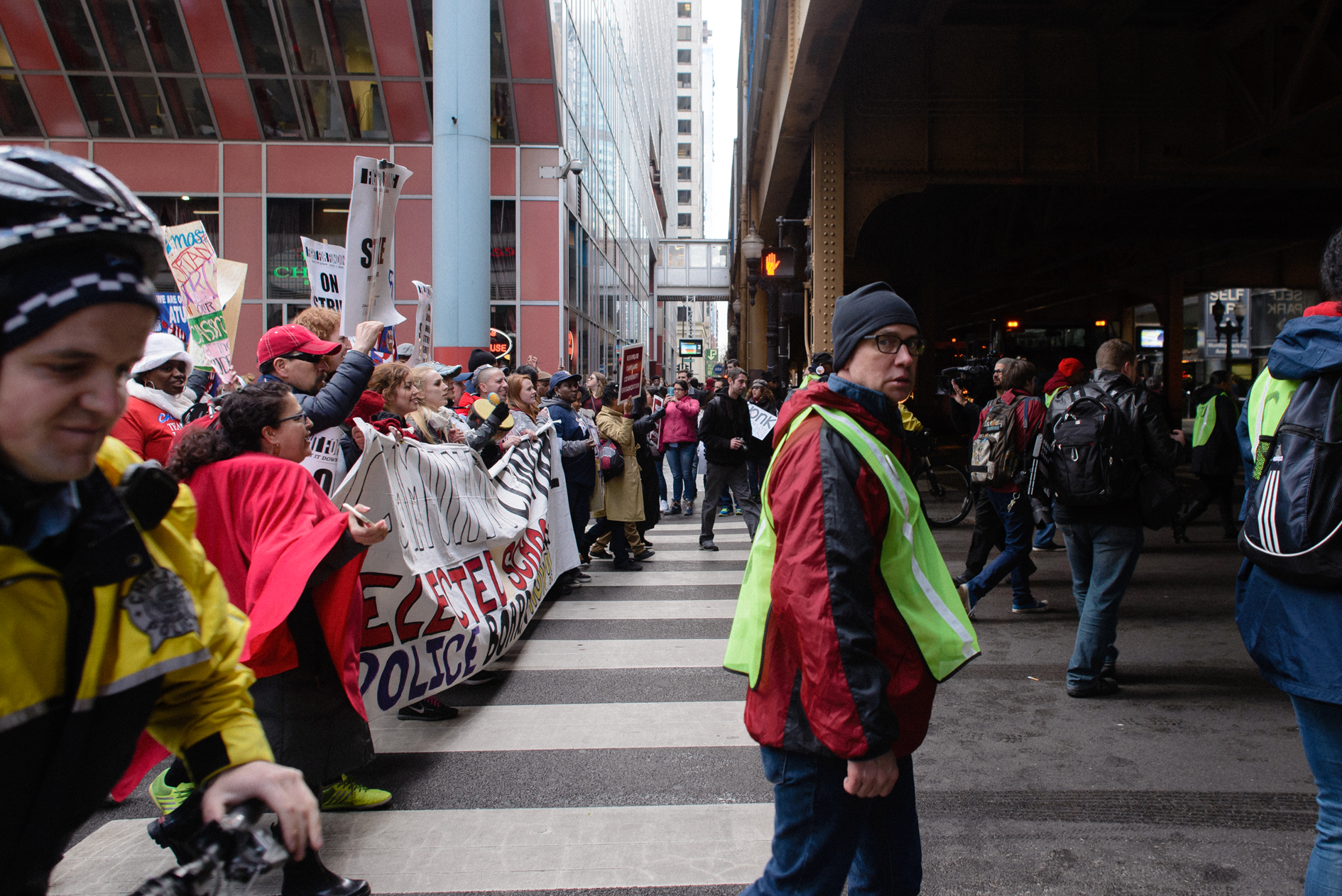As I begin my twenty-first year as an educator, I can honestly say I’ve never before felt the need to defend my profession as I have the last few years. When I started teaching at 22, I got lots of praise for choosing this career. But these days, I’m always on the defensive against so many people who have a negative view of teachers in Chicago Public Schools.
No other district in the state is as scrutinized, as criticized, or as dismissed as ours is. But teachers will not be victims. True, as a group, as a union, we have not done the best job communicating our motivation and intentions. For the last few years, this has been my mantra as a teacher leader:
As teachers, we fight for what’s best for students and what’s manageable for teachers.
After working for over a year without a contract, and pursuing contract negotiations with CPS leadership through the summer, 95.6 percent of Chicago Teachers Union (CTU) members voted in late September to authorize a strike, which has now been set for October 11.
This is how I summarize what Chicago Public Schools teachers are fighting for:
1. Maintain reasonable class sizes
CPS officials threatened us with staffing cuts that would squeeze forty students into single classrooms. Besides being impossible because of fire codes and the sizes of some of our classrooms, this would be damaging for students.
This threat reinforces the misunderstanding that our city leaders have of what good teachers do. We build professional relationships with our students and engage them with material that builds their academic and emotional intelligence. It’s already difficult with classes of twenty-five to thirty students or more. Forty students in one room and two hundred students a day for a high-school teacher would be chaos.
So, we need parents and community members to help us push against turmoil like this. And if it’s a bluff tactic to encourage us to put pressure on Springfield, CPS needs to stop playing games with students’ educations.
2. Decrease paperwork
District leaders, and principals sometimes, demand so much documentation that it’s impossible to keep up with the compliance tasks in one or two free non-teaching periods a day. This paperwork, which so often contributes so little to our teaching, robs us of time that we need to plan our teaching and engage with students in meaningful ways.
Testing has been decreased at the high-school level but the district still requires elementary schools to give an over-abundance of tests. When this data is generated, more needs to be done so that this data can be teacher-friendly, not administrator focused.
3. Increase support services for students
Teachers cannot do it all. Students need counselors, social workers, nurses, security staff, and librarians so their academic and social-emotional needs are met. Students also need to eat good food and walk around in clean schools.
In an effort to save money, our city and our district have cut positions outside of the classroom and contracted with companies that have not, or cannot, provide quality food and cleaning services. I want to emphasize here that it’s not the fault of the lunch staff or custodians—it’s the fault of the companies’ leaders who don’t give them the resources they need to do a better job.
Additionally, this year funding for special education teachers is not accurately determined by a school’s current need, and schools struggle to find enough certified teachers.

4. Increase funding for current schools
Instead of closing schools and cutting the funding for schools, teachers want CPS and city leaders to invest more than only about $5,000 in each student.
Business leaders—who seem to have all the answers to improve education—would never expect to get more from a product they put less into, at least not if they wanted the product to last. The monetary investment in students stays low, but the amount of resources needed to help today’s students gets higher and higher—especially with the trauma of violence in our city.
Teachers these days seem disposable to city leaders.
As for charter schools, I do believe charter schools have a place in our city (my children go to one). But I do think we need to reconsider the number of schools one charter school operator can have.
City politics influence which communities get new schools and which don’t. Let’s be honest: those neighborhoods with economic or political influence get more of the city’s investment.
5. Protect our livelihood and retirement.
As a former colleague, who worked in CPS for thirty-five and a half years, used to say, “A full day’s pay for a full day’s work.” Since the school year was extended a few years ago, teachers work uncompensated for about an hour a day—and this is not a lunch hour.
The school day for high school students was increased to seven and a half hours a day but teachers are only compensated for six hours and fifteen minutes each day. While we might not be directly in front of students for those seven and a half hours, we are in the building for working for over an hour without compensation.
Because the city and CPS leaders reallocated city funds that were supposed to go to pensions, they now expect teachers to take a seven-percent pay cut and solve their problem.
In this economy, I wonder if people have begun to equate a pension with a type of welfare. I can hear people say, “I’m not paying for your retirement.” I attribute this bitterness to the poor performance of our city leaders whose questionable decisions contribute to the tension and division of our historically divided city.
People will say I’m complaining and this is the old “I work so hard as a teacher” whining. But these critics would never think of publicly criticizing or devaluing the work of teachers in affluent cities. These critics will continue to suggest that Chicago teachers get paid too much. Quite simply, these critics will never see the good in Chicago Public Schools teachers.
We’re seeing the aftermath of this negative bias as less and less young people choose teaching as a profession—especially in high needs areas of special education and bilingual education.
This is why, as a labor organization, the Chicago Teachers Union must ensure every moment in front of the microphone and every tweet and press release and interaction communicates our fight clearly, sensibly, and accurately.
There’s a Spanish saying: “Hablando se entiende la gente.” Through dialogue, people understand each other.
So it’s essential that we—a labor organization that must exist to protect teachers—continue to push each other to have the difficult conversations. Through this dialogue, we will move forward more effectively and more unified. Despite what some union members think, tough conversations won’t break us apart.
In late August, the CTU sent members an update on our position in the contract negotiations. This update shifted our fight from a monologue—which I think it has been for a long time—to a dialogue about what’s best for students and what’s manageable for teachers. This is a conversation every Chicago resident has to have with teachers, not for teachers. And every member of the CTU must contribute to this dialogue by ensuring we, too, communicate our fight for what’s best for students and manageable for teachers clearly, sensibly, and accurately.
This column was first published on Ray’s blog, The White Rhino (www.chicagonow.com/white-rhino/) on September 1.
Since 1995, Ray Salazar has been an English teacher in Chicago Public Schools and is a National Board Certified teacher. He started writing The White Rhino about education and Latino issues in 2011. Ray lives on the Southwest Side. Follow him on Twitter @WhiteRhinoRay



